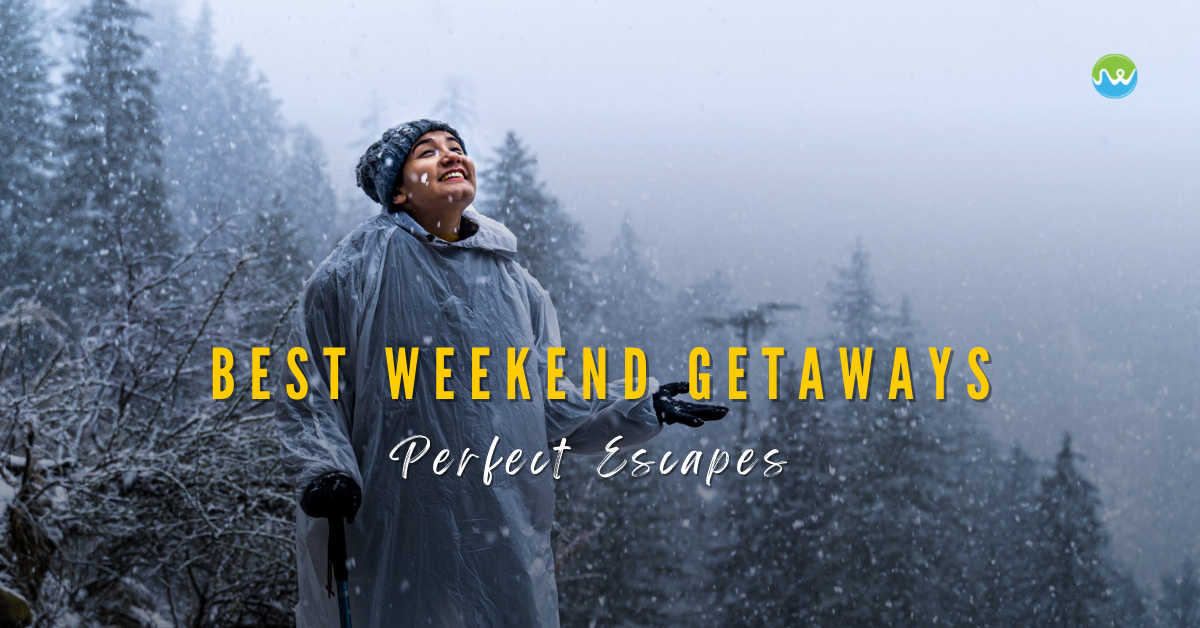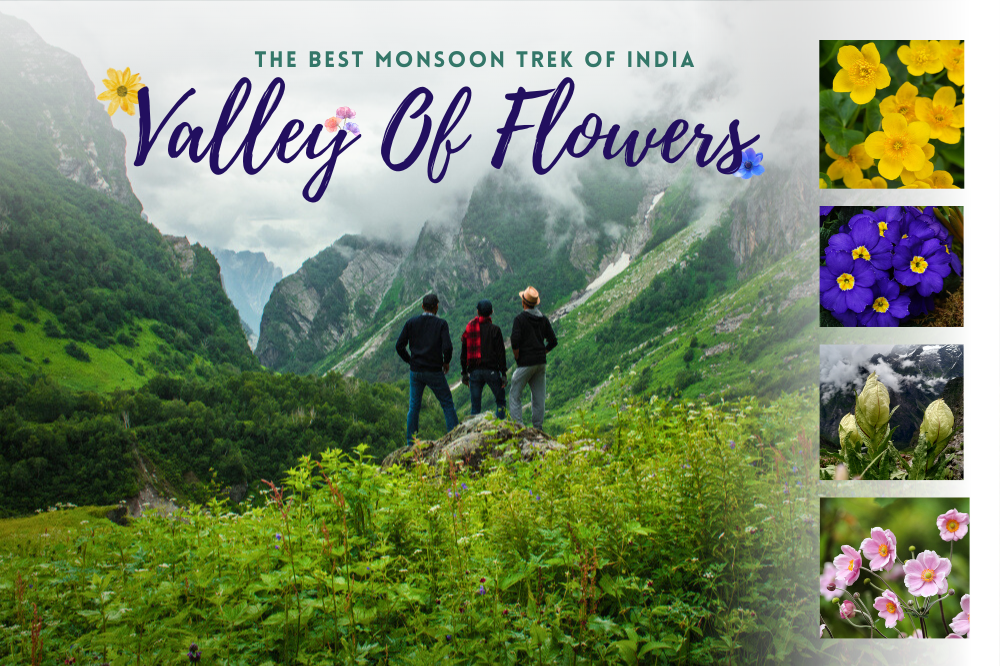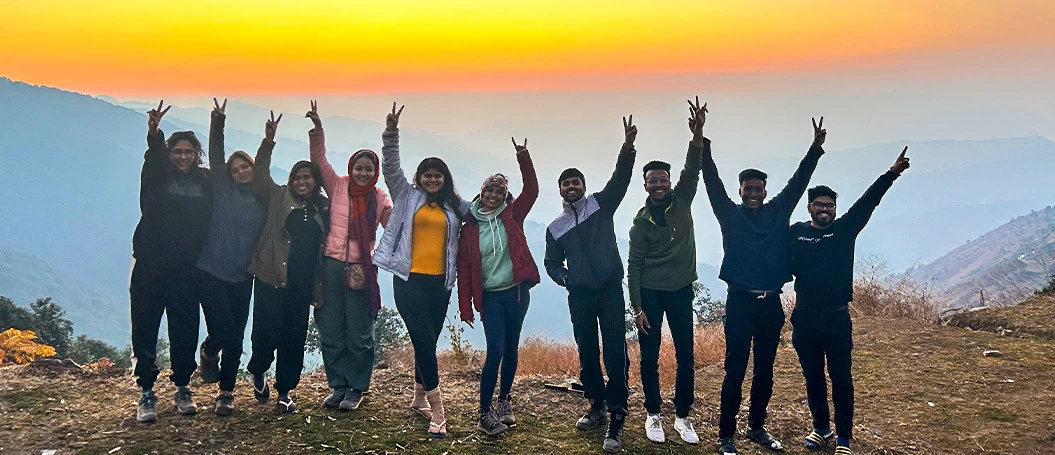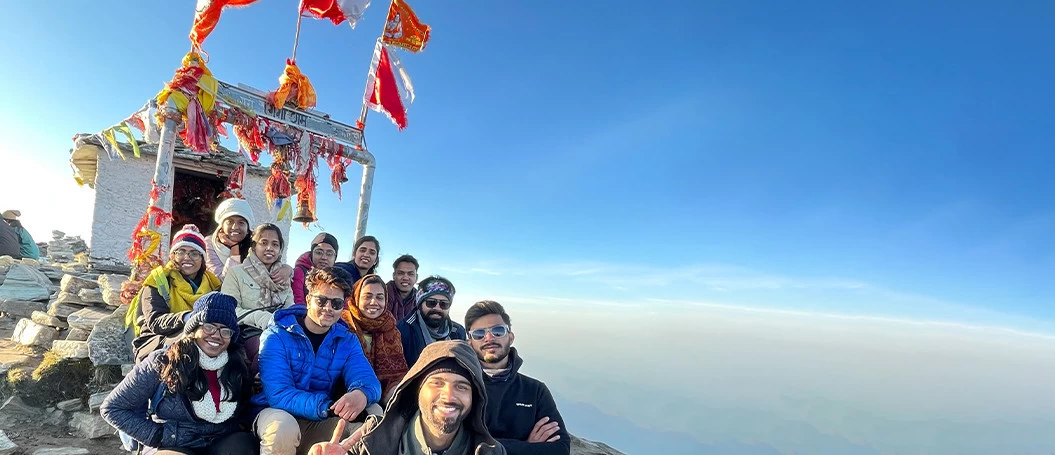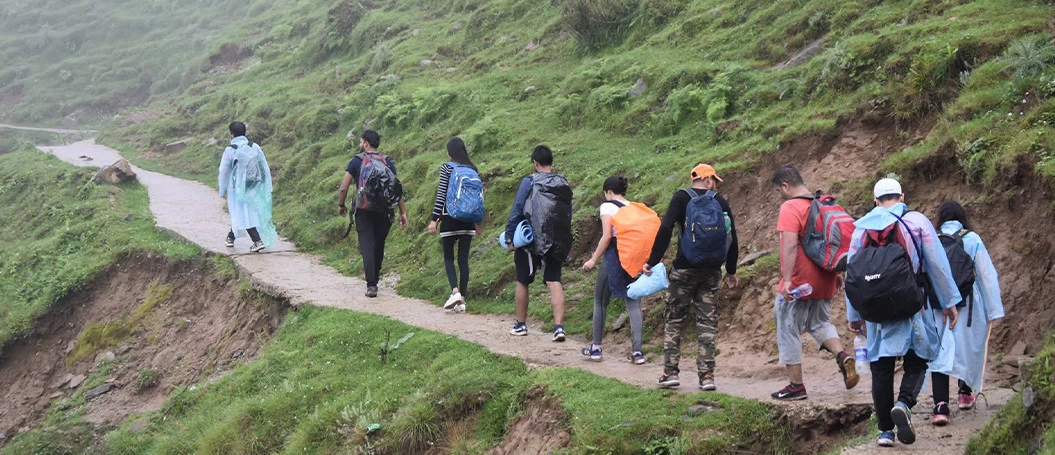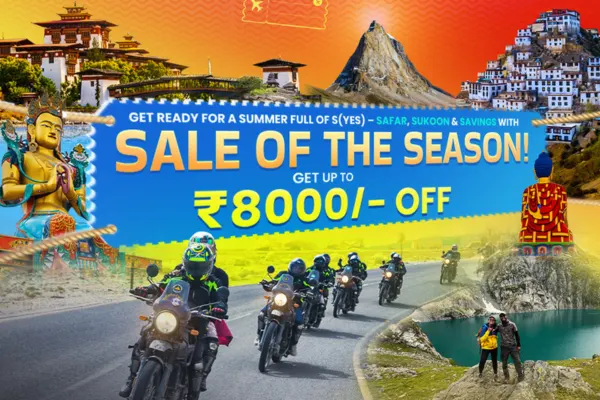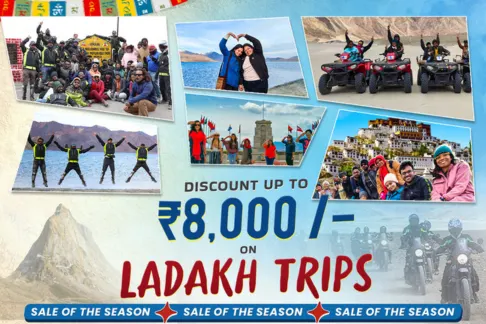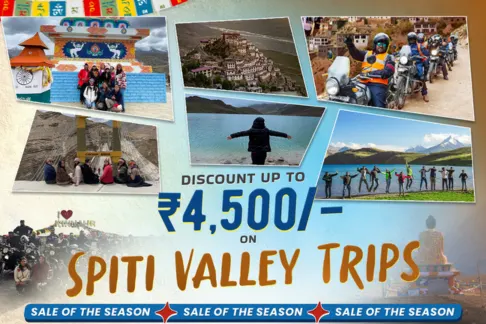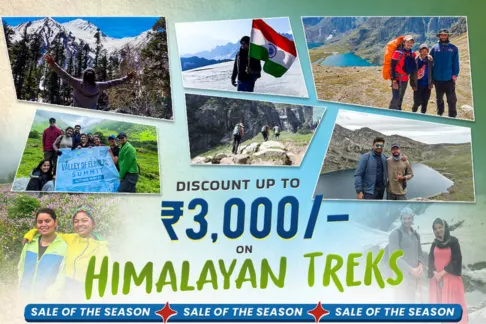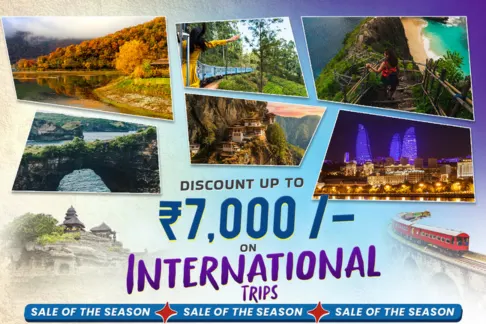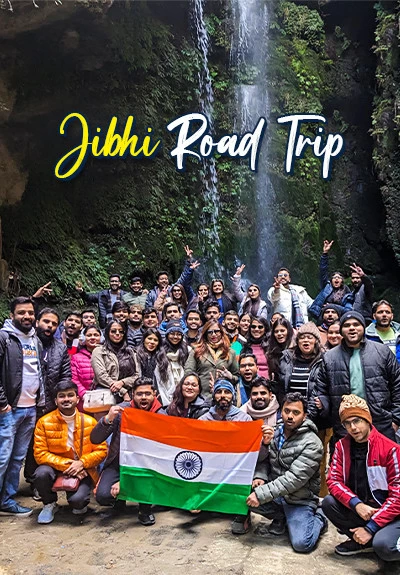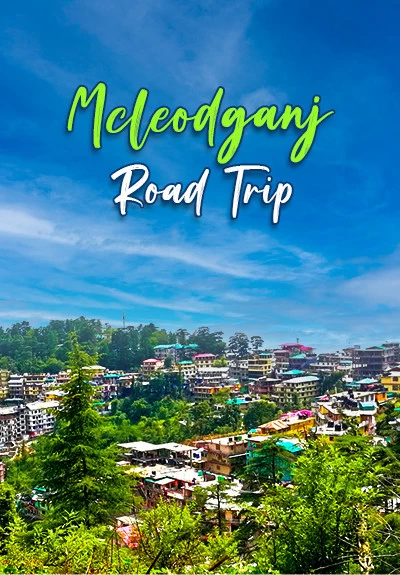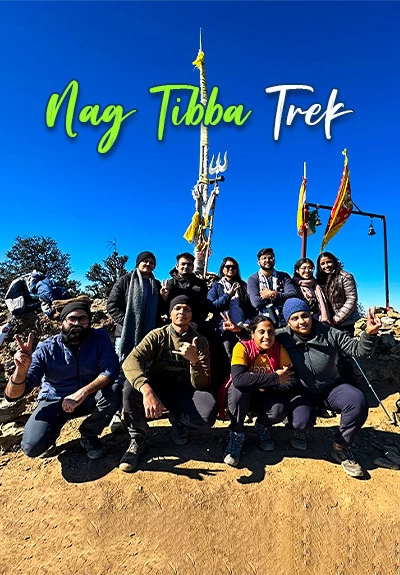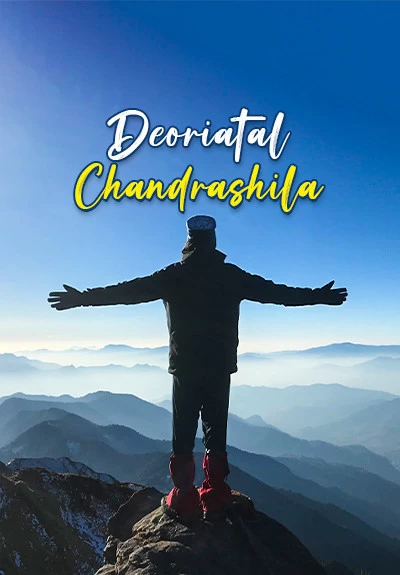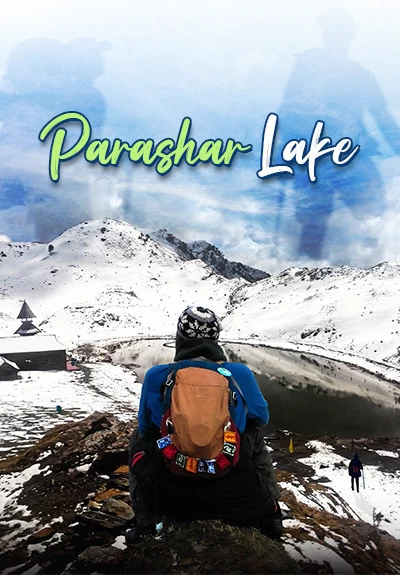
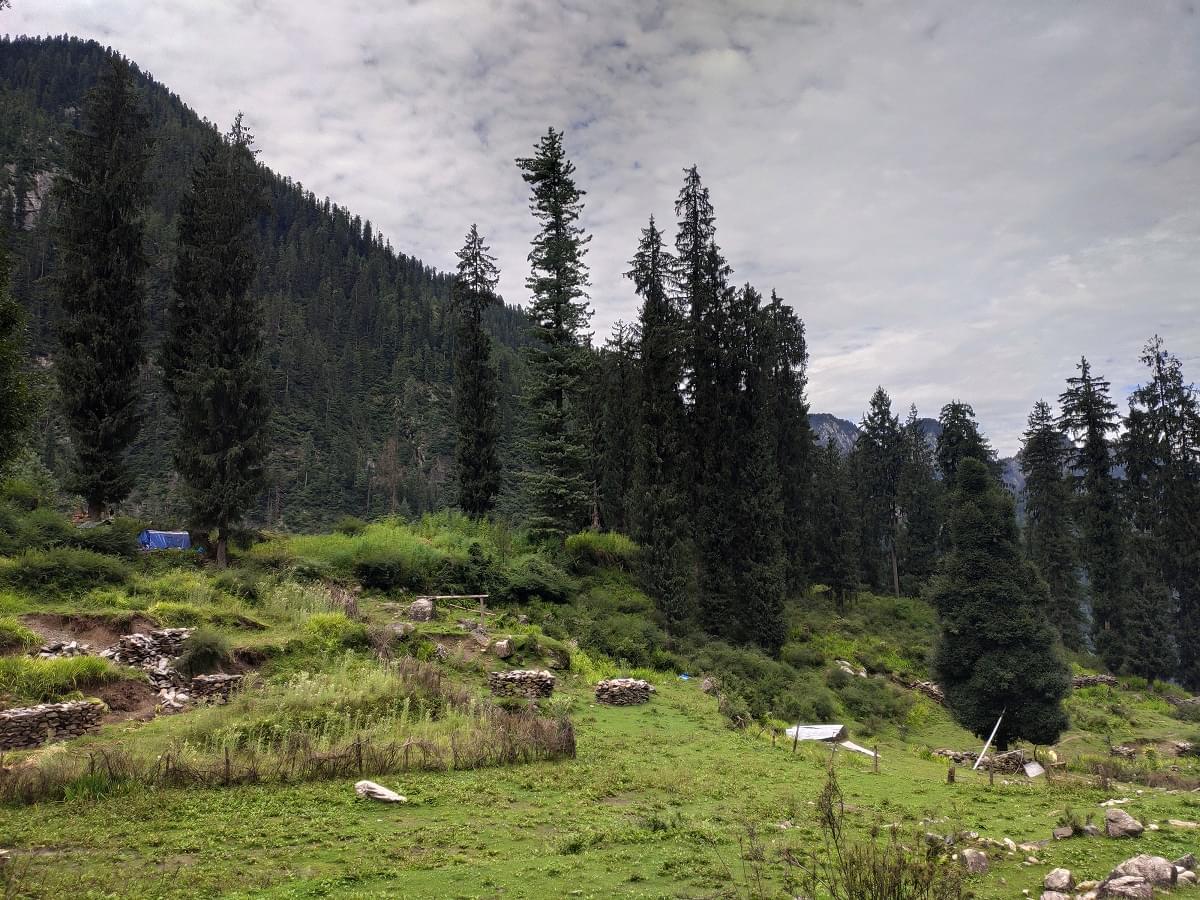
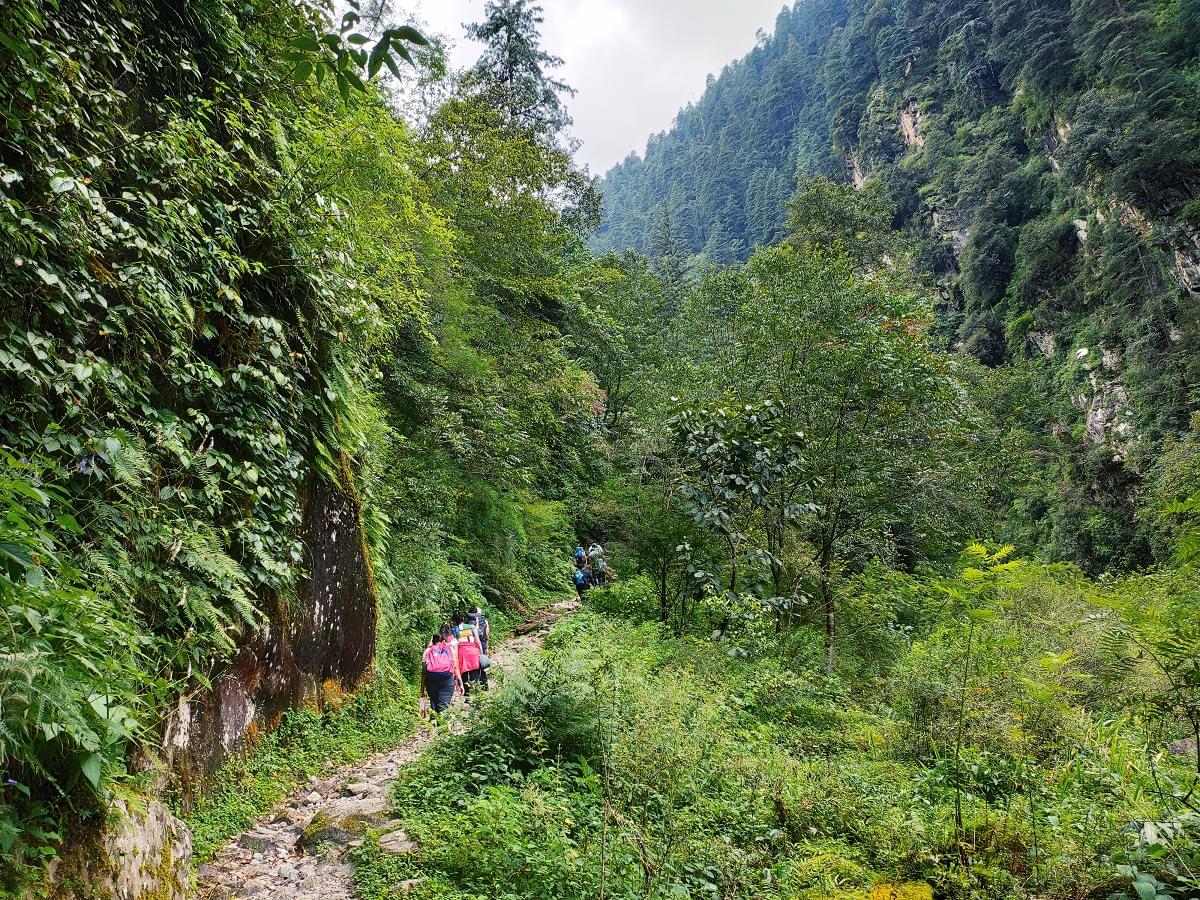
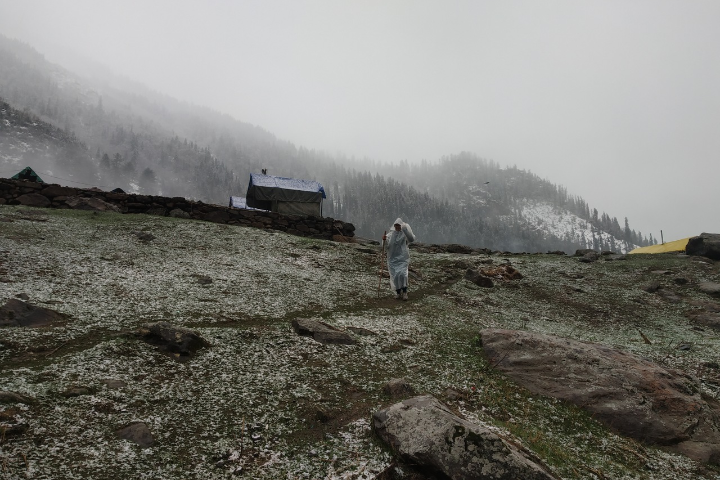
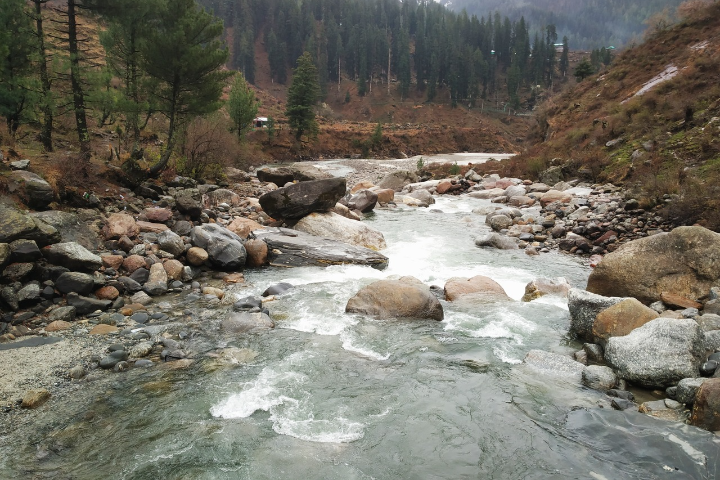
Kheerganga Trek
Details
Inclusions
Safe Travel
Flexible Cancellation
Easy EMI
Certified Captains
24/7 Support
Overview
Kheerganga trek is one of the most well-known destinations for trekking and is located at an altitude of 9,700 ft. Nestled deep in the Parvati Valley, it’s considered nature’s paradise as the beauty is almost spellbinding. The Itinerary for the Kheerganga Trek starts with a drive from Delhi to Kasol. Then, the actual trek commences from Kasol itself which is a tiny hamlet in Himachal Pradesh’s Kullu district. Kasol is emerging as a popular tourist location best for budget traveling among young travelers. You can enjoy a night's stay in Kasol where you can indulge in camping, sit by the Parvati river, and go cafe hopping before we embark on the Kheerganga trek the next day. All you need are two days to get completely mesmerized by the landscapes and witness the picturesque views. The Kheerganga trek reveals stunning terrains and provides an invigorating experience when one keeps walking on its enchanting trails. Here, you get to enjoy the lush green valleys in their purest form, hear the chirping of birds that has faded with time in metropolitan cities, and experience peace like no other.
You’ll also get a chance to learn about the culture of Kheerganga while camping there. The history of Kheerganga dates back thousands of years and the place is considered the abode of Lord Shiva. The best time to do the Kheerganga trek is from September to June as the weather is pleasant and you can experience the true essence of this Himalayan trek with crystal clear skies and breathtaking vistas. If you prefer a warmer climate and want to witness the spring flowers blooming all across the vast expanse of land, then March to June are the best months to do the Kheerganga trek. If you wish to trek on snow-laden trails where the entire landscape is covered in ivory white, then the months from November to February would be ideal to do the Kheerganga trek in winter. Hot water springs and breathtaking views are a few things that make Kheerganga trek a truly beautiful experience. The phenomenon of hot water springs in the midst of such cold weather fascinates a lot of travelers and adds a certain boost to the tourism of Kasol and Kheerganga. The Kheerganga trek is a beginner-level trek as there is a gentle incline and it only gets steep at some patches in the trail making it easier for novice trekkers who don’t have a lot of experience to get the feel of walking on the mountains. You can rejuvenate yourself by dipping your feet in the cold water as there are many sparkling waterfalls on the trek route. One of them is Rudranag waterfall, which is the grandest waterfall you’ll encounter on this trek. The sparkling waterfall with snow-capped peaks in the background and dense forest all around make it a perfect natural retreat. Additionally, the Rudranag temple that is nestled along the way to Kheerganga is also very popular amongst many pilgrims. The total distance covered during the Kheerganga trek is 12 Kilometers making it ideal for novice trekkers as it doesn’t exhaust them and they get to experience both the thrill and solace that the mountains provide them.
There are plenty of things to do in Kheerganga. While you’re on the trek, there are plenty of quaint villages that will offer the option of a homestay where you can indulge in insightful conversations with the locals, learn more about the history of the place and relish authentic Himachali food. You also get to traverse the rustic village of Barshaini as you embark on the Kheerganga trek and enjoy stunning views of enchanting forests, and sparkling waterfalls en route. An important fact about Kasol and Kheerganga that travelers should note is that Kasol is the last stop where you’ll find an ATM. Also, if your inner adventurer is awakened, then you can also opt for indulging in thrilling activities that Kasol has to offer including trekking, rafting, hiking, and more.
Gallery




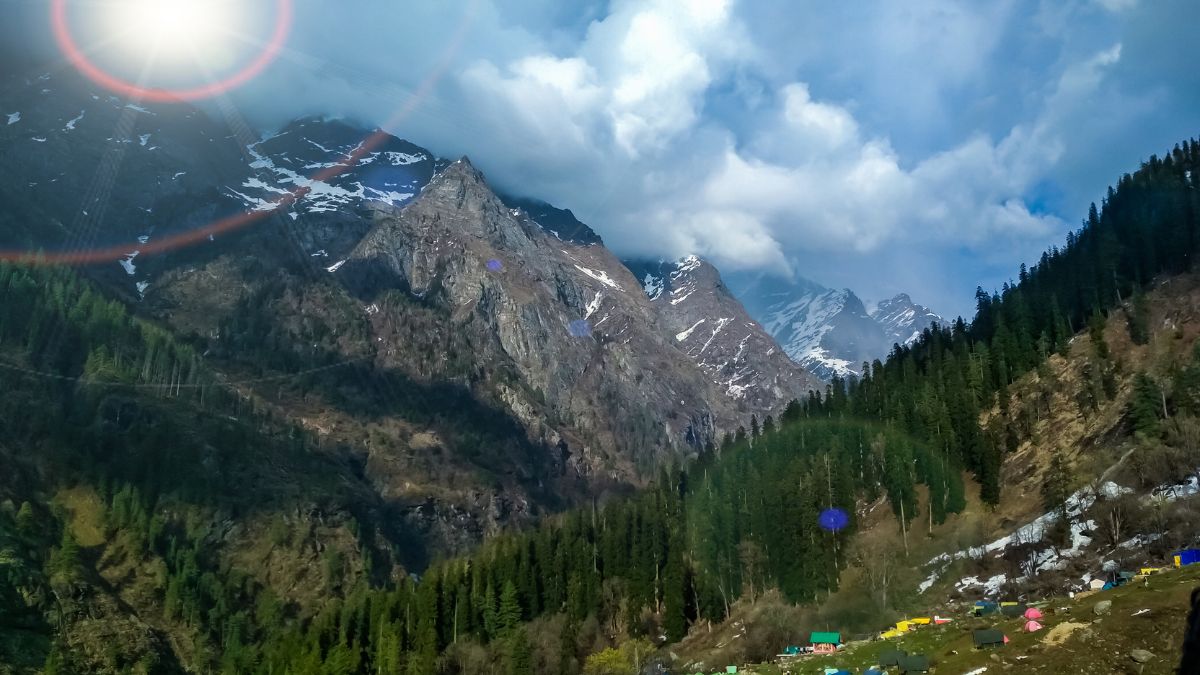
Itinerary
0
Day
Drive from Delhi to Kasol ( 514 Kilometers)
1
Day
Chalal Village Sightseeing Day | Cafe Hopping
2
Day
Trek to Kheerganga | Return to Rudranaag (15 kms)
3
Day
Back to Kasol | Departure
4
Day
Delhi Arrival | Trip Ends
Age Limit (Trip Wise)
Weekend
Getaways
18-38
Himalayan
Treks
18-48
Backpacking
Trips
18-40
Biking
Trips
18-45
Customized
Trips
No Limit
Inclusions & Exclusions
| Inclusions | Exclusions |
Transportation: Tempo Traveler / AC Volvo Bus tickets for Delhi to Delhi transportation Surface transport from Kasol to Barshaini and back Accommodation: 1 Night Accommodation in Hotel and 1 Night Accommodation in Camps Sightseeing as per the Itinerary Meal Plan based on MAPAI : (Total 5 Meals - 2 Meals on Day 1 (L+D) + 2 Meals on Day 2 (B+D) + 1 Meal on Day 3 (B)) ( Veg and Non- veg Dinner on Day 2) Evening Tea and cookies in Kheerganga Bonfire The trip Captain will be present at all times during the tour. Local Guide First Aid Kits All required Permits Driver Allowance Toll Taxes and other state taxes Parking Charges | 5% GST Early check-in (Before 1:00 PM) & Late Check-out (After 11:00 AM) at the hotel. Any additional expenses of personal nature. Additional accommodation/food costs incurred due to any delay travel. Any lunch and other meals not mentioned in Package Inclusions. Any Airfare / Rail fare other than what is mentioned in “Inclusions”. Parking and monument entry fees during sightseeing. Additional Costs due to Flight Cancellations, Landslides, Roadblocks, and other natural calamities. Any other services not specified above in inclusions. |
Cancellation Policy
| Upto 16 days | 15-8 days | 7-3 days | 2-0 days | |
| Batch Shifting | ||||
| Cancellation Charge | Free Cancellation | 25% of the Trip Amount | 50% of the Trip Amount | 100% of the Trip Amount |
| Booking Amount | Refunded in mode of Credit Note | Adjusted in Refund Deduction | Adjusted in Refund Deduction | No Refund |
| Remaining Amount | Full Refund (minus) booking amount | Refund (minus) 25% of the trip amount | Refund (minus) 50% of the trip amount | No Refund |
Payment Policy
| Upto 16 days | 15-08 days | 07-03 days | 02-0 days | |
|---|---|---|---|---|
| Booking Amount | ||||
| 50% Payment | Optional | Compulsory | ||
| 75% Payment | Optional | Optional | Compulsory | |
| 100% Payment | Optional | Optional | Optional | Compulsory |
Things To Pack
Rucksack:
You must pick a good quality backpack with a comfortable fit and straps that won’t give you shoulder pain. You can check out your nearest Decathlon store for a good trekking backpack.
You must pick a good quality backpack with a comfortable fit and straps that won’t give you shoulder pain. You can check out your nearest Decathlon store for a good trekking backpack.
Day Bag / Day Pack:
When you head towards the summit, you are required to carry only a few necessary items and for that, you need a day backpack as you will leave your bigger one on the campsite.
When you head towards the summit, you are required to carry only a few necessary items and for that, you need a day backpack as you will leave your bigger one on the campsite.
Hiking Shoes :
Durable footwear designed for rugged terrains.
Durable footwear designed for rugged terrains.
Floaters or Sandals:
Although the entire trek requires a good quality shoe, you still need to let your feet breathe to avoid chafing and blisters. When you are at the camp, a good pair of sandals and floaters will help you to move freely.
Although the entire trek requires a good quality shoe, you still need to let your feet breathe to avoid chafing and blisters. When you are at the camp, a good pair of sandals and floaters will help you to move freely.
Tees / Tshirts:
You must keep at least three pairs of quick dry tees so that you can wash them in between stops for proper hygiene.
You must keep at least three pairs of quick dry tees so that you can wash them in between stops for proper hygiene.
Poncho:
A poncho is an evolved form of a raincoat that provides coverage to your body as well as your bag and ensures total water protection from rain.
A poncho is an evolved form of a raincoat that provides coverage to your body as well as your bag and ensures total water protection from rain.
Quick Dry Towel:
A quick dry towel will help in maintaining proper hygiene. It must dry quickly because the wet fabric will only increase the chance of bacterial growth.
A quick dry towel will help in maintaining proper hygiene. It must dry quickly because the wet fabric will only increase the chance of bacterial growth.
Sanitizer:
Essential for maintaining cleanliness while trekking.
Essential for maintaining cleanliness while trekking.
Sun Cap / Hat:
A lightweight sun cap with side flaps is perfect to keep your head cool and avoid sunburns on a sunny day.
A lightweight sun cap with side flaps is perfect to keep your head cool and avoid sunburns on a sunny day.
Sunscreen SPF 40+:
To avoid sunburns and chafing, you need to put on sunscreen as well as cold cream.
To avoid sunburns and chafing, you need to put on sunscreen as well as cold cream.
Water Bottle (Re-usable):
Hydration is extremely important when it comes to trekking. Carrying a water bottle that you can refill with Himalayan water is a must.
Hydration is extremely important when it comes to trekking. Carrying a water bottle that you can refill with Himalayan water is a must.
Personal Toiletries:
A bag with all your essentials including napkins, toothpaste, sanitizers, paper soap, etc should be carried in a ziplock bag.
A bag with all your essentials including napkins, toothpaste, sanitizers, paper soap, etc should be carried in a ziplock bag.
Personal Medication / First Aid:
A few cuts and bruises are almost inevitable when you are on a trek so carrying a medical kit with bandages, Dettol, etc is necessary.
A few cuts and bruises are almost inevitable when you are on a trek so carrying a medical kit with bandages, Dettol, etc is necessary.
Sun Glasses / Reading Glasses:
Photochromatic glasses are specs that are designed to transform into anti-glare shades depending upon exposure to the sun. They are good when it comes to eye protection but one can also opt for clip-on glasses etc.
Photochromatic glasses are specs that are designed to transform into anti-glare shades depending upon exposure to the sun. They are good when it comes to eye protection but one can also opt for clip-on glasses etc.
Charger:
To keep your electronic devices powered during the trip.
To keep your electronic devices powered during the trip.
Power Bank:
Ensures your devices stay charged when there are no outlets.
Ensures your devices stay charged when there are no outlets.
Personal Documents & ID's:
Identification proofs like Aadhar Card, Drivers License.
Identification proofs like Aadhar Card, Drivers License.
Laundry Bag (Waterproof):
In case your clothes get wet or your garments don’t dry, you can carry them in polythene. However, make sure that all the plastic that you are carrying into the woods leaves with you. Don’t litter in the mountains.
In case your clothes get wet or your garments don’t dry, you can carry them in polythene. However, make sure that all the plastic that you are carrying into the woods leaves with you. Don’t litter in the mountains.
Track Pants:
A good pair of track pants made of polyester will let your skin breathe. They’re lightweight, dry easily, and comfortable to walk around in. You can easily avoid chafing and rashes by investing in a good pair of track pants.
A good pair of track pants made of polyester will let your skin breathe. They’re lightweight, dry easily, and comfortable to walk around in. You can easily avoid chafing and rashes by investing in a good pair of track pants.
Trekking Shoes:
A good trekking shoe is comfortable, provides ankle support, and has a good grip as well. They shouldn’t be chunky, instead, they should be lightweight and sturdy.
A good trekking shoe is comfortable, provides ankle support, and has a good grip as well. They shouldn’t be chunky, instead, they should be lightweight and sturdy.
Cotton Socks:
Cotton socks are extremely comfortable to move around in and are lightweight as well which is why you can always count on a good pair of cotton socks while trekking. However, keep in mind to change them and avoid wearing them when they are wet.
Cotton socks are extremely comfortable to move around in and are lightweight as well which is why you can always count on a good pair of cotton socks while trekking. However, keep in mind to change them and avoid wearing them when they are wet.
Woolen Socks:
A good pair of woolen socks, especially merino, are comfortable, limit odors and provide adequate insulation from the cold so you can wear them at night.
A good pair of woolen socks, especially merino, are comfortable, limit odors and provide adequate insulation from the cold so you can wear them at night.
Woolen Gloves:
Insulated gloves help in maintaining proper body heat in your hands and also provide a better grasp on trekking poles.
Insulated gloves help in maintaining proper body heat in your hands and also provide a better grasp on trekking poles.
Main Jacket:
It’s emphasized that you need to carry proper layers so you can avoid getting cold which is why you need to carry a heavy jacket that you can put on over your other clothes.
It’s emphasized that you need to carry proper layers so you can avoid getting cold which is why you need to carry a heavy jacket that you can put on over your other clothes.
Woolen Cap:
A woolen cap will help prevent cold when you ascend to high altitude. You can also cover your ears to avoid any pain and discomfort you might face in them when going at high altitudes.
A woolen cap will help prevent cold when you ascend to high altitude. You can also cover your ears to avoid any pain and discomfort you might face in them when going at high altitudes.
Hoodie:
A versatile layering option for various temperatures.
A versatile layering option for various temperatures.
Scarf / Balaclava:
Along with sun rays and chilly winds, you also get hit by dirt and grime during treks which is why it's important to carry a scarf or balaclava so you can cover your face when needed.
Along with sun rays and chilly winds, you also get hit by dirt and grime during treks which is why it's important to carry a scarf or balaclava so you can cover your face when needed.
Head Lamp:
You can’t rely on moonlight when you are in the mountains. A torch or even a headlamp with a fresh pair of batteries is always a good idea to bring along.
You can’t rely on moonlight when you are in the mountains. A torch or even a headlamp with a fresh pair of batteries is always a good idea to bring along.
Trekking Pole:
The trekking pole assists in more than one way. It saves energy while also providing stability and helps you to maintain proper balance.
The trekking pole assists in more than one way. It saves energy while also providing stability and helps you to maintain proper balance.
Camera:
This should be obvious. To make sure that you get to capture all the great moments from your trek. Make sure that you have enough storage and some extra batteries as well.
This should be obvious. To make sure that you get to capture all the great moments from your trek. Make sure that you have enough storage and some extra batteries as well.
Riding Gear:
If your trip involves biking or motorcycling.
If your trip involves biking or motorcycling.
Moisturiser & Cold Cream:
To avoid sunburns and chafing, you need to put on sunscreen as well as cold cream.
To avoid sunburns and chafing, you need to put on sunscreen as well as cold cream.
Lip Balm:
Your lips can become chapped due to the harsh cold winds so it's important to keep them moisturized.
Your lips can become chapped due to the harsh cold winds so it's important to keep them moisturized.
Sanitary Pads:
Essential for feminine hygiene.
Essential for feminine hygiene.
Insect Repellent:
Guards against pesky bugs and insects.
Guards against pesky bugs and insects.
Cash:
Emergency funds for unexpected situations.
Emergency funds for unexpected situations.
Thermals:
Thermal is a piece of garment that helps in keeping your body warm in cold temperatures. It is a necessary item that you need when going on a high-altitude trek.
Thermal is a piece of garment that helps in keeping your body warm in cold temperatures. It is a necessary item that you need when going on a high-altitude trek.
Snacks / Dryfruits / Energy Bar:
Provides quick energy on the go.
Provides quick energy on the go.
Positive Attitude:
The most important item for a successful trek or trip, keeping your spirits high and adaptable to the challenges of the journey.
The most important item for a successful trek or trip, keeping your spirits high and adaptable to the challenges of the journey.
REVIEWS
What our Clients Say About Us
blogs
Our Blogs
Faq
Have any Doubts
What Are The Famous Places To Visit In Kasol?
You can visit nearby villages such as Tosh, Malana, Chalal, Grahan, and More along with famous places like Manikaran Saheb, Kasol Main Market, Jim Morrison Market, German Bakery, and a lot of things.
What Is the highest altitude attained during the Kheerganga Trek?
The altitude for Kheerganga Trek is 9,700 ft.
What Is The distance between Barshaini and Kheerganga?
Barshaini is the starting point for the Kheerganga Trek. From here, all you have to do is trek up for 12 Kilometers to reach the top. The trail is adorned by enchanting forests with the Parvati river flowing all along.
Is It Possible To Do the Kheerganga Trek In May?
Yes! You can go to Kheerganga in May, and it is one of the best months to do the Kheerganga trek.
Is It Possible To Do the Kheerganga Trek In November?
Partially No! The reason for saying that is, the Kheerganga Trek gets closed from the end of November till the end of February due to heavy snowfall and slippery slopes. This is why you cannot do a trek during that time.
What Is The Starting Point for the Kheerganga trek?
Barshaini is the starting point for the trek. The trail to Kheerganga is adorned by coniferous forests with the Parvati river flowing alongside. The trek is popular for a picturesque view of the entire valley as well as the hot springs that await the trekker at the top.
Is It Possible To Do the Kheerganga Trek In March?
Yes! Kheerganga trek is readily operable during March, as it is the month when the trek restarts for the better part of the year and closes back in November.
What Is The Best Way To Do the Trek From Kasol To Kheerganga?
To go to Kheerganga from Kasol, you'll first have to reach Barshaini, and from there onwards, the only way to go is to follow the trail for 12 Kilometers.
How Much Time Does It Take To Cover The Distance Between Kasol To Kheerganga Trek?
It takes somewhere between 3-5 hours comfortably while trekking up towards the Kheerganga Top. But, It depends from person to person. People who are expert trekkers can even complete the trek in less than 1.5 hours. You'll find localities carrying heavy baggage and still trekking up in less than record times because they are used to walking up the hills.
What is the best time to do the Kheerganga trek?
You can go for the Kheerganga Trek during the whole year except for the end of November to Mid February. Depending on the kind of landscape you want to witness, the ideal time can differ.
Best months to do the Kheerganga trek during Summer: June, July, August, and September.
Best months to do the Kheerganga trek during Winter: November, December, January, and February.
TRIPS
Related Trips





Kheerganga Trek
Details
Inclusions
Safe Travel
Flexible Cancellation
Easy EMI
Certified Captains
24/7 Support
Overview
Kheerganga trek is one of the most well-known destinations for trekking and is located at an altitude of 9,700 ft. Nestled deep in the Parvati Valley, it’s considered nature’s paradise as the beauty is almost spellbinding. The Itinerary for the Kheerganga Trek starts with a drive from Delhi to Kasol. Then, the actual trek commences from Kasol itself which is a tiny hamlet in Himachal Pradesh’s Kullu district. Kasol is emerging as a popular tourist location best for budget traveling among young travelers. You can enjoy a night's stay in Kasol where you can indulge in camping, sit by the Parvati river, and go cafe hopping before we embark on the Kheerganga trek the next day. All you need are two days to get completely mesmerized by the landscapes and witness the picturesque views. The Kheerganga trek reveals stunning terrains and provides an invigorating experience when one keeps walking on its enchanting trails. Here, you get to enjoy the lush green valleys in their purest form, hear the chirping of birds that has faded with time in metropolitan cities, and experience peace like no other.
You’ll also get a chance to learn about the culture of Kheerganga while camping there. The history of Kheerganga dates back thousands of years and the place is considered the abode of Lord Shiva. The best time to do the Kheerganga trek is from September to June as the weather is pleasant and you can experience the true essence of this Himalayan trek with crystal clear skies and breathtaking vistas. If you prefer a warmer climate and want to witness the spring flowers blooming all across the vast expanse of land, then March to June are the best months to do the Kheerganga trek. If you wish to trek on snow-laden trails where the entire landscape is covered in ivory white, then the months from November to February would be ideal to do the Kheerganga trek in winter. Hot water springs and breathtaking views are a few things that make Kheerganga trek a truly beautiful experience. The phenomenon of hot water springs in the midst of such cold weather fascinates a lot of travelers and adds a certain boost to the tourism of Kasol and Kheerganga. The Kheerganga trek is a beginner-level trek as there is a gentle incline and it only gets steep at some patches in the trail making it easier for novice trekkers who don’t have a lot of experience to get the feel of walking on the mountains. You can rejuvenate yourself by dipping your feet in the cold water as there are many sparkling waterfalls on the trek route. One of them is Rudranag waterfall, which is the grandest waterfall you’ll encounter on this trek. The sparkling waterfall with snow-capped peaks in the background and dense forest all around make it a perfect natural retreat. Additionally, the Rudranag temple that is nestled along the way to Kheerganga is also very popular amongst many pilgrims. The total distance covered during the Kheerganga trek is 12 Kilometers making it ideal for novice trekkers as it doesn’t exhaust them and they get to experience both the thrill and solace that the mountains provide them.
There are plenty of things to do in Kheerganga. While you’re on the trek, there are plenty of quaint villages that will offer the option of a homestay where you can indulge in insightful conversations with the locals, learn more about the history of the place and relish authentic Himachali food. You also get to traverse the rustic village of Barshaini as you embark on the Kheerganga trek and enjoy stunning views of enchanting forests, and sparkling waterfalls en route. An important fact about Kasol and Kheerganga that travelers should note is that Kasol is the last stop where you’ll find an ATM. Also, if your inner adventurer is awakened, then you can also opt for indulging in thrilling activities that Kasol has to offer including trekking, rafting, hiking, and more.
Itinerary
0
Day
Drive from Delhi to Kasol ( 514 Kilometers)
1
Day
Chalal Village Sightseeing Day | Cafe Hopping
2
Day
Trek to Kheerganga | Return to Rudranaag (15 kms)
3
Day
Back to Kasol | Departure
4
Day
Delhi Arrival | Trip Ends
Age Limit (Trip Wise)
Weekend
Getaways
18-38
Himalayan
Treks
18-48
Backpacking
Trips
18-40
Biking
Trips
18-45
Customized
Trips
No Limit
Pricing
Select Occupancy
+5% GST *
Transportation: Tempo Traveler / AC Volvo Bus tickets for Delhi to Delhi transportation Surface transport from Kasol to Barshaini and back Accommodation: 1 Night Accommodation in Hotel and 1 Night Accommodation in Camps Sightseeing as per the Itinerary Meal Plan based on MAPAI : (Total 5 Meals - 2 Meals on Day 1 (L+D) + 2 Meals on Day 2 (B+D) + 1 Meal on Day 3 (B)) ( Veg and Non- veg Dinner on Day 2) Evening Tea and cookies in Kheerganga Bonfire The trip Captain will be present at all times during the tour. Local Guide First Aid Kits All required Permits Driver Allowance Toll Taxes and other state taxes Parking Charges |
Cancellation Policy
Credit Note :
The Booking Amount will be credited to your JW Profile which can be accessed by logging in to the website through your Email ID. Credit Notes issued have no date of expiry and can be used entirely in any of your future trips.
GST :
The Booking Amount will be credited to your JW Profile which can be accessed by logging in to the website through your Email ID. Credit Notes issued have no date of expiry and can be used entirely in any of your future trips.
Payment Policy
Things To Pack
Rucksack:
You must pick a good quality backpack with a comfortable fit and straps that won’t give you shoulder pain. You can check out your nearest Decathlon store for a good trekking backpack.
You must pick a good quality backpack with a comfortable fit and straps that won’t give you shoulder pain. You can check out your nearest Decathlon store for a good trekking backpack.
Day Bag / Day Pack:
When you head towards the summit, you are required to carry only a few necessary items and for that, you need a day backpack as you will leave your bigger one on the campsite.
When you head towards the summit, you are required to carry only a few necessary items and for that, you need a day backpack as you will leave your bigger one on the campsite.
Hiking Shoes :
Durable footwear designed for rugged terrains.
Durable footwear designed for rugged terrains.
Floaters or Sandals:
Although the entire trek requires a good quality shoe, you still need to let your feet breathe to avoid chafing and blisters. When you are at the camp, a good pair of sandals and floaters will help you to move freely.
Although the entire trek requires a good quality shoe, you still need to let your feet breathe to avoid chafing and blisters. When you are at the camp, a good pair of sandals and floaters will help you to move freely.
Tees / Tshirts:
You must keep at least three pairs of quick dry tees so that you can wash them in between stops for proper hygiene.
You must keep at least three pairs of quick dry tees so that you can wash them in between stops for proper hygiene.
Poncho:
A poncho is an evolved form of a raincoat that provides coverage to your body as well as your bag and ensures total water protection from rain.
A poncho is an evolved form of a raincoat that provides coverage to your body as well as your bag and ensures total water protection from rain.
Quick Dry Towel:
A quick dry towel will help in maintaining proper hygiene. It must dry quickly because the wet fabric will only increase the chance of bacterial growth.
A quick dry towel will help in maintaining proper hygiene. It must dry quickly because the wet fabric will only increase the chance of bacterial growth.
Sanitizer:
Essential for maintaining cleanliness while trekking.
Essential for maintaining cleanliness while trekking.
Sun Cap / Hat:
A lightweight sun cap with side flaps is perfect to keep your head cool and avoid sunburns on a sunny day.
A lightweight sun cap with side flaps is perfect to keep your head cool and avoid sunburns on a sunny day.
Sunscreen SPF 40+:
To avoid sunburns and chafing, you need to put on sunscreen as well as cold cream.
To avoid sunburns and chafing, you need to put on sunscreen as well as cold cream.
Water Bottle (Re-usable):
Hydration is extremely important when it comes to trekking. Carrying a water bottle that you can refill with Himalayan water is a must.
Hydration is extremely important when it comes to trekking. Carrying a water bottle that you can refill with Himalayan water is a must.
Personal Toiletries:
A bag with all your essentials including napkins, toothpaste, sanitizers, paper soap, etc should be carried in a ziplock bag.
A bag with all your essentials including napkins, toothpaste, sanitizers, paper soap, etc should be carried in a ziplock bag.
Personal Medication / First Aid:
A few cuts and bruises are almost inevitable when you are on a trek so carrying a medical kit with bandages, Dettol, etc is necessary.
A few cuts and bruises are almost inevitable when you are on a trek so carrying a medical kit with bandages, Dettol, etc is necessary.
Sun Glasses / Reading Glasses:
Photochromatic glasses are specs that are designed to transform into anti-glare shades depending upon exposure to the sun. They are good when it comes to eye protection but one can also opt for clip-on glasses etc.
Photochromatic glasses are specs that are designed to transform into anti-glare shades depending upon exposure to the sun. They are good when it comes to eye protection but one can also opt for clip-on glasses etc.
Charger:
To keep your electronic devices powered during the trip.
To keep your electronic devices powered during the trip.
Power Bank:
Ensures your devices stay charged when there are no outlets.
Ensures your devices stay charged when there are no outlets.
Personal Documents & ID's:
Identification proofs like Aadhar Card, Drivers License.
Identification proofs like Aadhar Card, Drivers License.
Laundry Bag (Waterproof):
In case your clothes get wet or your garments don’t dry, you can carry them in polythene. However, make sure that all the plastic that you are carrying into the woods leaves with you. Don’t litter in the mountains.
In case your clothes get wet or your garments don’t dry, you can carry them in polythene. However, make sure that all the plastic that you are carrying into the woods leaves with you. Don’t litter in the mountains.
Track Pants:
A good pair of track pants made of polyester will let your skin breathe. They’re lightweight, dry easily, and comfortable to walk around in. You can easily avoid chafing and rashes by investing in a good pair of track pants.
A good pair of track pants made of polyester will let your skin breathe. They’re lightweight, dry easily, and comfortable to walk around in. You can easily avoid chafing and rashes by investing in a good pair of track pants.
Trekking Shoes:
A good trekking shoe is comfortable, provides ankle support, and has a good grip as well. They shouldn’t be chunky, instead, they should be lightweight and sturdy.
A good trekking shoe is comfortable, provides ankle support, and has a good grip as well. They shouldn’t be chunky, instead, they should be lightweight and sturdy.
Cotton Socks:
Cotton socks are extremely comfortable to move around in and are lightweight as well which is why you can always count on a good pair of cotton socks while trekking. However, keep in mind to change them and avoid wearing them when they are wet.
Cotton socks are extremely comfortable to move around in and are lightweight as well which is why you can always count on a good pair of cotton socks while trekking. However, keep in mind to change them and avoid wearing them when they are wet.
Woolen Socks:
A good pair of woolen socks, especially merino, are comfortable, limit odors and provide adequate insulation from the cold so you can wear them at night.
A good pair of woolen socks, especially merino, are comfortable, limit odors and provide adequate insulation from the cold so you can wear them at night.
Woolen Gloves:
Insulated gloves help in maintaining proper body heat in your hands and also provide a better grasp on trekking poles.
Insulated gloves help in maintaining proper body heat in your hands and also provide a better grasp on trekking poles.
Main Jacket:
It’s emphasized that you need to carry proper layers so you can avoid getting cold which is why you need to carry a heavy jacket that you can put on over your other clothes.
It’s emphasized that you need to carry proper layers so you can avoid getting cold which is why you need to carry a heavy jacket that you can put on over your other clothes.
Woolen Cap:
A woolen cap will help prevent cold when you ascend to high altitude. You can also cover your ears to avoid any pain and discomfort you might face in them when going at high altitudes.
A woolen cap will help prevent cold when you ascend to high altitude. You can also cover your ears to avoid any pain and discomfort you might face in them when going at high altitudes.
Hoodie:
A versatile layering option for various temperatures.
A versatile layering option for various temperatures.
Scarf / Balaclava:
Along with sun rays and chilly winds, you also get hit by dirt and grime during treks which is why it's important to carry a scarf or balaclava so you can cover your face when needed.
Along with sun rays and chilly winds, you also get hit by dirt and grime during treks which is why it's important to carry a scarf or balaclava so you can cover your face when needed.
Head Lamp:
You can’t rely on moonlight when you are in the mountains. A torch or even a headlamp with a fresh pair of batteries is always a good idea to bring along.
You can’t rely on moonlight when you are in the mountains. A torch or even a headlamp with a fresh pair of batteries is always a good idea to bring along.
Trekking Pole:
The trekking pole assists in more than one way. It saves energy while also providing stability and helps you to maintain proper balance.
The trekking pole assists in more than one way. It saves energy while also providing stability and helps you to maintain proper balance.
Camera:
This should be obvious. To make sure that you get to capture all the great moments from your trek. Make sure that you have enough storage and some extra batteries as well.
This should be obvious. To make sure that you get to capture all the great moments from your trek. Make sure that you have enough storage and some extra batteries as well.
Riding Gear:
If your trip involves biking or motorcycling.
If your trip involves biking or motorcycling.
Moisturiser & Cold Cream:
To avoid sunburns and chafing, you need to put on sunscreen as well as cold cream.
To avoid sunburns and chafing, you need to put on sunscreen as well as cold cream.
Lip Balm:
Your lips can become chapped due to the harsh cold winds so it's important to keep them moisturized.
Your lips can become chapped due to the harsh cold winds so it's important to keep them moisturized.
Sanitary Pads:
Essential for feminine hygiene.
Essential for feminine hygiene.
Insect Repellent:
Guards against pesky bugs and insects.
Guards against pesky bugs and insects.
Cash:
Emergency funds for unexpected situations.
Emergency funds for unexpected situations.
Thermals:
Thermal is a piece of garment that helps in keeping your body warm in cold temperatures. It is a necessary item that you need when going on a high-altitude trek.
Thermal is a piece of garment that helps in keeping your body warm in cold temperatures. It is a necessary item that you need when going on a high-altitude trek.
Snacks / Dryfruits / Energy Bar:
Provides quick energy on the go.
Provides quick energy on the go.
Positive Attitude:
The most important item for a successful trek or trip, keeping your spirits high and adaptable to the challenges of the journey.
The most important item for a successful trek or trip, keeping your spirits high and adaptable to the challenges of the journey.
Similar Packages
REVIEWS
What our Clients Say About Us
blogs
Our Blogs
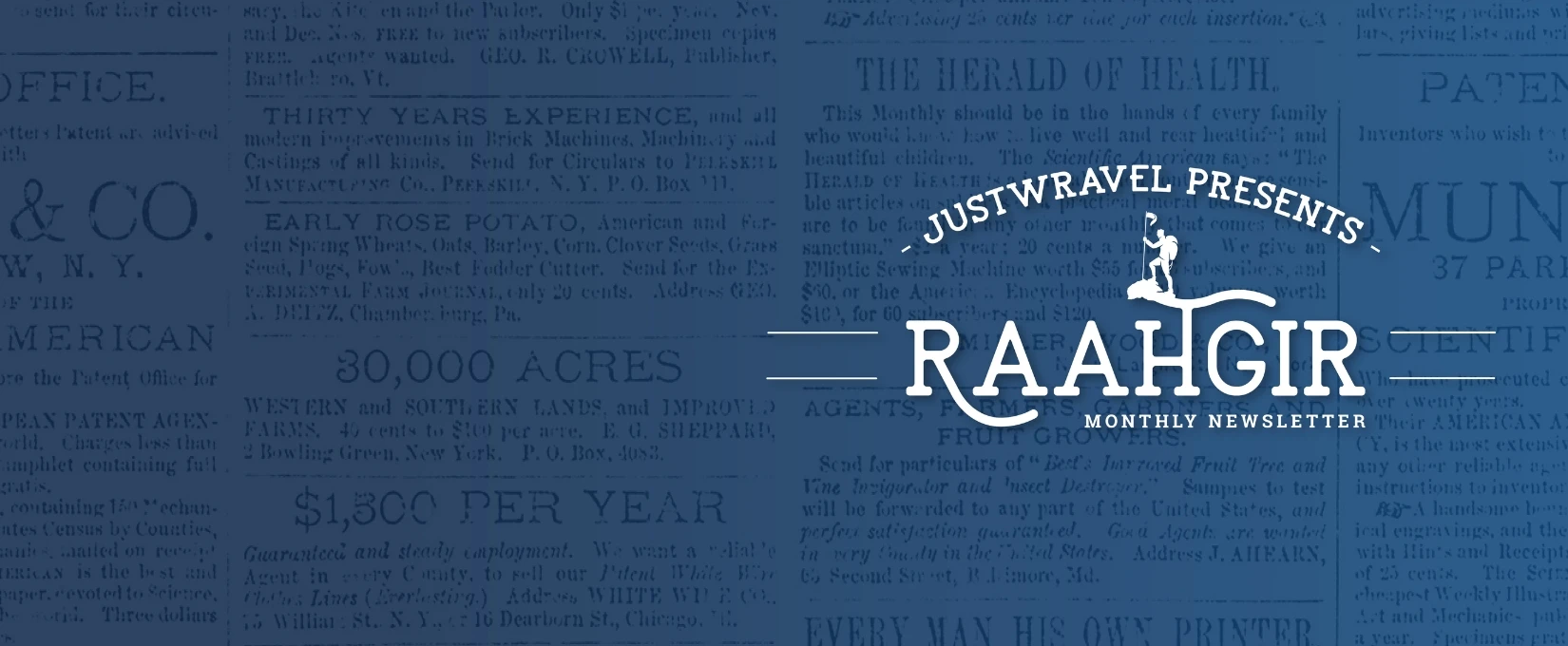
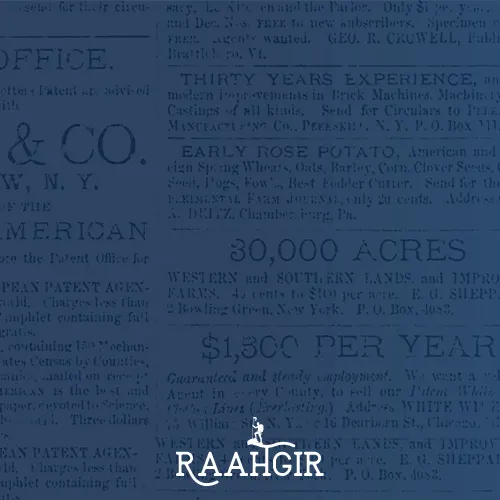
Newsletter
Sign up now!
Be the first one to know all about the Exciting Offers, Travel Updates and more.

B-42, 2nd Floor, Tower- B, The Corenthum, Block A, Sector 62, Noida, Uttar Pradesh 201301
© 2015-2025 JustWravel Pvt. Ltd.




